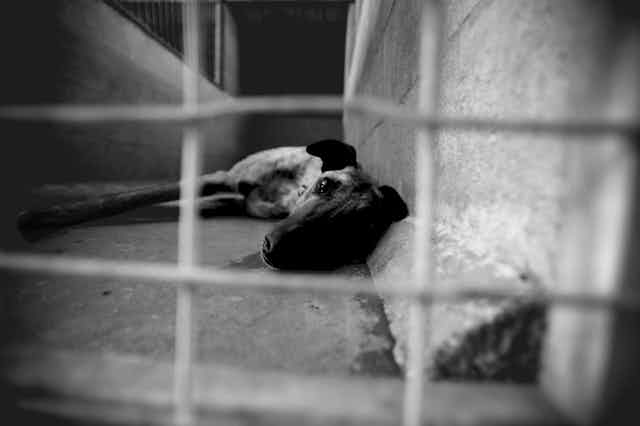Background Briefing’s program The Quick and the Dead exposed one of the key animal welfare issues facing the greyhound racing industry: the high rates of euthanasia of healthy dogs.
During an interview, Brent Hogan, CEO of Greyhound Racing NSW, stated that in NSW alone around 3,000 greyhounds bred for the racing industry are euthanised every year. These include healthy dogs that have been deemed too slow for competition, those whose racing “career” is at end, and others who may be euthanised following injury on the track.
After listening to the program I remembered an article a friend had given me about a greyhound, Mandy, who had been rescued from a factory fire in Marrickville. An attending paramedic recounted “It is the first time I’ve rescued a dog … we treated her the same as you would a human for smoke inhalation and dehydration”. Mandy’s owner said she would be “forever grateful” to the paramedics who treated Mandy “like a person” to ensure her survival.

Then there is Ted Humphries, interviewed as part of the Background Briefing program. A former vet for the racing industry, Mr Humphries euthanises greyhounds as part of his veterinary practice. Under Australian animal protection laws authorising the killing of an animal by the animal’s owner is lawful, as long as the pain and suffering inflicted on the animal during the act of killing does not amount to cruelty. Mr Humphries explained that if he was not willing to euthanise these dogs humanely, there is a distinct possibility that they would meet a more brutal end: shot, killed by hanging, drowning, gassed, or even hit over the head with a hammer.
These two stories sit in apparent contrast. One has to do with saving lives, the other with killing. I wondered about the practice ethics underpinning these scenarios.
Although they focus on different species, both vets and paramedics are health practitioners. Their practice shares common ground in that it is informed by an ethic of care, compassion, and the alleviation of suffering.
Indeed, in Mandy’s case, the actions of the paramedics involved demonstrated that this ethic of care crosses the species boundary. Mr Humphries’s practice also adheres to this ethic of care in that it ameliorates animal suffering by preventing the cruelty inherent in other forms of killing. His decision to euthanise healthy dogs is made between a rock and a hard place: it is not something he takes lightly.
To my mind, vets like Ted Humphries carry a heavy moral burden on behalf of the rest of society. Why is he put into this difficult position in the first place?
To gain some insight it is worthwhile considering some basic principles about the concept of animal welfare as the foundation for our animal protection regulatory system.
The animal welfare paradigm allows for the use of animals on the basis that the pain and suffering endured by the animals involved is for legitimate human benefit. According to this utilitarian approach, human benefits must be balanced against the interests of animals.

Ultimately, it is the side on which the scales fall that decides whether specific forms of animal use and associated practices are imbued with legitimacy. The question of whether animal use is for a legitimate purpose generally accords with a hierarchy in which animal use for food and research has a strong moral claim. In comparison, animal use for non-essential purposes such as entertainment, sport, or luxury items, has a weaker moral claim.
In these latter cases one might expect that, at least on occasion, the interests of animals might trump ours.
Given that the greyhound racing industry requires the large scale killing of animals each year (remember the 3,000 per year figure was for NSW alone), it seems that the industry’s claim on legitimacy is becoming increasingly shaky.
Lastly, the question of practice ethics arises. Compassion figured largely in the paramedics and Ted Humphries’s interaction with animals. This made me wonder about the core values underpinning human interactions with animals in the racing industry. Would it be possible to develop an approach to animal welfare that has compassion as its core?
In invoking compassion I am thinking of Milan Kundera’s interpretation in The Unbearable Lightness of Being. Kundera explains that in Czech, Polish, German, and Swedish, the word “compassion” has as it root “feeling” rather than “suffering”. Hence, to have compassion (co-feeling) means not only to be able to live with the other’s misfortune but also to feel with him any emotion – joy, anxiety, happiness, pain.
This kind of compassion signifies the maximal capacity of affective imagination, the art of emotional telepathy. In the hierarchy of sentiments, then, it is supreme.

